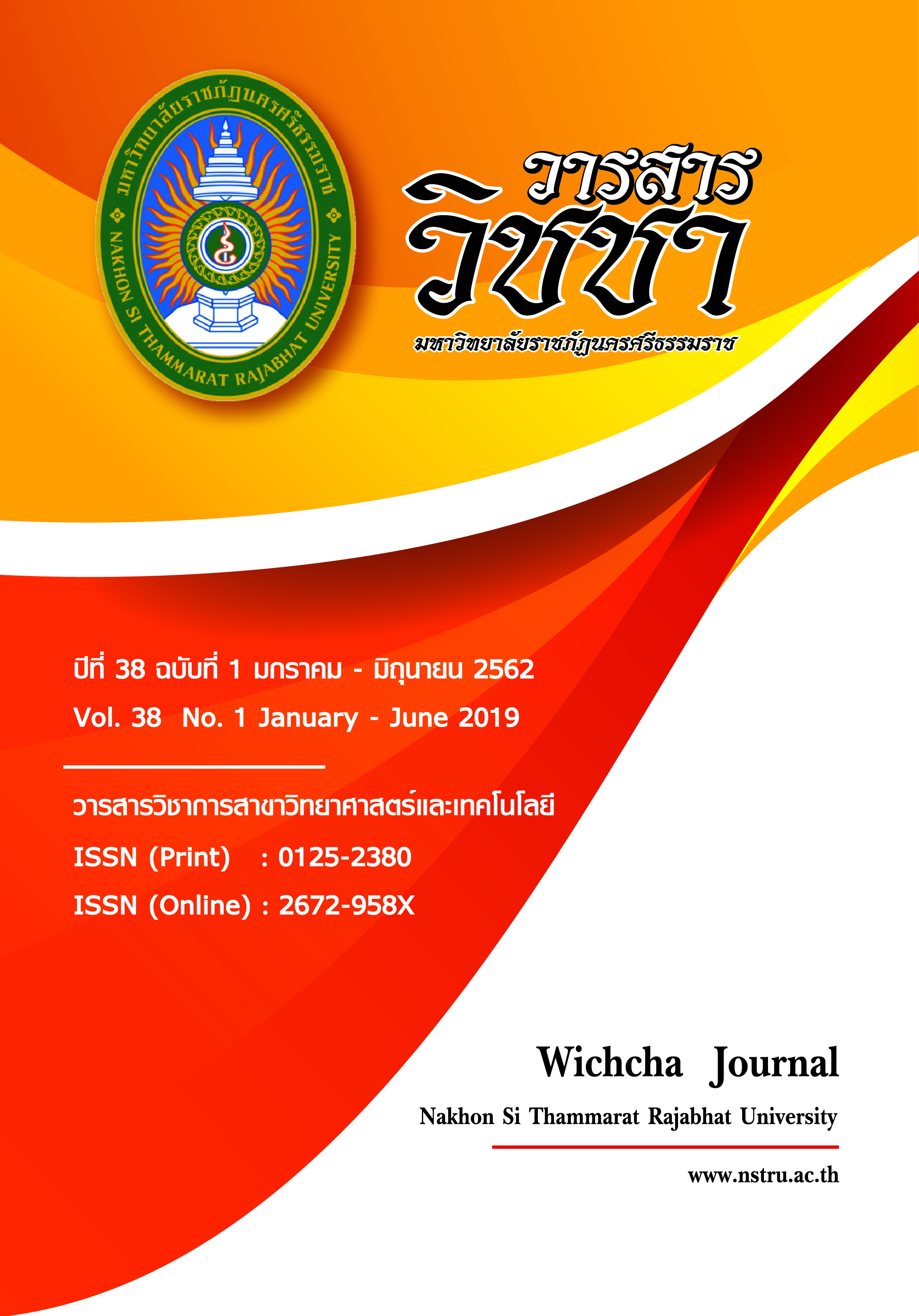Effects of Extraction Solvents and pH on the Amount and Stability of Crude Color Extracted from Plants ผลของตัวทำละลายและความเป็นกรด-ด่าง ต่อปริมาณและความคงตัวของสารสีที่สกัดได้จากพืช
Main Article Content
บทคัดย่อ
งานวิจัยนี้มีวัตถุประสงค์ เพื่อศึกษาผลของตัวทำละลายต่อปริมาณสารที่สกัดได้จากธรรมชาติ และศึกษาความคงตัวของสีย้อมจากธรรมชาติที่ความเป็นกรด-ด่างต่าง ๆ โดยใช้พืชตัวอย่างทั้งหมด 5 ชนิด ได้แก่ ใบสาบเสือ เปลือกสนทะเล ใบเพกา แก่นขนุน และเปลือกผลมังคุด ผลการวิจัย พบว่า ตัวทำละลายแต่ละชนิดสามารถสกัดสีย้อมจากธรรมชาติได้ในปริมาณที่แตกต่างกันโดยตัวทำละลายที่มีขั้ว ได้แก่ เมทานอล และน้ำกลั่น สามารถสกัดสารจากพืช เช่น ใบสาบเสือ และเปลือกผลมังคุดออกมาได้ดีที่สุด ขณะที่ตัวทำละลายที่ไม่มีขั้ว เช่น เฮกเซน สามารถสกัดสารจากแก่นขนุนได้ดีกว่า และจากการศึกษาความคงตัวของสีย้อมจากธรรมชาติที่ความเป็นกรด-ด่างต่าง ๆ โดยวัดค่าการดูดกลืนแสงสูงสุดด้วยเครื่อง UV-Visible spectrophotometer เทียบเฉดสีกับ Munsel color chart และวัดค่าสีด้วยระบบ L*a*b ด้วยเครื่องวัดสี พบว่า สีย้อมแต่ละชนิดมีเฉดสีและความเข้มของสีย้อมแตกต่างกันในช่วงความเป็นกรด-ด่างต่าง ๆ สารสกัดใบสาบเสือจากทุกตัวทำละลายมีแนวโน้มของเฉดสีที่เข้มขึ้นในสภาวะที่เป็นเบส สารสกัดอะซิโตนและเมทานอลจากเปลือกสนทะเล จะให้สีที่เข้มที่ความเป็นกรด-ด่างเท่ากับ 12 สารสกัดไดคลอโรมีเทน อะซิโตน และเมทานอลจากใบเพกา จะให้สีเหลือง และจะมีสีเข้มสุดในสารสกัดเมทานอลที่ความเป็นกรด-ด่างเท่ากับ 12 เช่นเดียวกับสารสกัดสีย้อมจากเปลือกมังคุดของทุกตัวทำละลายจะให้สีเข้มสุดที่ความเป็นกรด-ด่างเท่ากับ 12 ขณะที่สารสกัดสีย้อมจากแก่นขนุนในตัวทำละลายอะซิโตน เมทานอล และน้ำ ให้สีน้ำตาล-แดงที่ค่อนข้างเข้ม แต่จะไม่ค่อยแตกต่างกันในแต่ละช่วงความเป็นกรด-ด่าง งานวิจัยนี้แสดงให้เห็นว่าตัวทำละลายและความเป็นกรด-ด่างมีผลต่อปริมาณและความเข้มของสีที่สกัดได้จากธรรมชาติ
Article Details
เนื้อหาและข้อมูลในบทความที่ลงตีพิมพ์ในวารสารวิชชา มหาวิทยาลัยราชภัฏนครศรีธรรมราช ถือเป็นข้อคิดเห็นและความรับผิดชอบของผู้เขียนบทความโดยตรง ซึ่งกองบรรณาธิการวารสารไม่จำเป็นต้องเห็นด้วยหรือร่วมรับผิดชอบใด ๆ
บทความ ข้อมูล เนื้อหา รูปภาพ ฯลฯ ที่ได้รับการตีพิมพ์ในวารสารวิชชา มหาวิทยาลัยราชภัฏนครศรีธรรมราช ถือเป็นลิขสิทธ์ของวารสารวิชชา มหาวิทยาลัยราชภัฏนครศรีธรรมราช หากบุคคลหรือหน่วยงานใดต้องการนำข้อมูลทั้งหมดหรือส่วนหนึ่งส่วนใดไปเผยแพร่ต่อหรือเพื่อการกระทำการใด ๆ จะต้องได้รับอนุญาตเป็นลายลักษณ์อักษรจากวารสารวิชชา มหาวิทยาลัยราชภัฏนครศรีธรรมราชก่อนเท่านั้น
The content and information in the article published in Wichcha journal Nakhon Si Thammarat Rajabhat University, It is the opinion and responsibility of the author of the article. The editorial journals do not need to agree. Or share any responsibility.
เอกสารอ้างอิง
ดารณี ขันเพ็ชร และวิรัน วิสุทธิธาดา. (2556). อิทธิพลของสารมอร์แดนท์ต่อสมบัติการย้อมเส้นด้ายฝ้ายด้วยสีธรรมชาติที่สกัดจากใบสัก. วารสารวิชาการและวิจัย มทร.พระนคร, (ฉบับพิเศษ), 357-363.
นันทิพย์ หาสิน และฉัตรดาว ไชยหล่อ. (2559). การศึกษากระบวนการสกัดสีธรรมชาติจากพืช เพื่องานมัดย้อม. ใน การประชุมวิชาการระดับชาติ นอร์ทเทิร์นวิจัย ครั้งที่ 3 (หน้า 513-516). ตาก: วิทยาลัยนอร์ทเทิร์น.
นุชนาถ มีพันธ์ ศศิประภา รัตนดิลก ณ ภูเก็ต และศรันยา คุณะดิลก (2559). การย้อมผ้าไหมด้วยสีย้อมธรรมชาติจากเหง้ากระชายดำ. วารสารคหเศรษฐศาสตร์, 59(2), 26-35.
ปิยะธิดา สีหะวัฒนกุล และอนุสรณ์ ใจทน. (2556). การศึกษากระบวนการย้อมสีใบตองแห้งด้วยสีธรรมชาติและสีวิทยาศาสตร์เพื่องานศิลปะประดิษฐ์. กรุงเทพฯ: คณะเทคโนโลยีคหกรรมศาสตร์ มหาวิทยาลัยเทคโนโลยีราชมงคลพระนคร.
พรพิมล ม่วงไทย สุจิตรา ศรีสังข์ นงนุช พรมรงศ์ และชุติมาพร วรรณวงษ์. (2553). การเตรียมผงสีย้อมจากเปลือกมังคุดบนสารดูดซับ. การประชุมวิชาการ มหาวิทยาลัยเกษตรศาสตร์ วิทยาเขตกำแพงแสน ครั้งที่ 7 (หน้า 1975-1984). นครปฐม: มหาวิทยาลัยเกษตรศาสตร์ วิทยาเขตกำแพงแสน
ระมัด โชชัย. (2556). การย้อมสีเส้นด้ายฝ้ายด้วยสีย้อมธรรมชาติจากใบและเปลือกต้นมะม่วงสำหรับอุตสาหกรรมครอบครัว. วารสารวิจัยเพื่อการพัฒนาเชิงพื้นที่, 5(4), 116-127.
วีรนุช วอนเก่าน้อย พันธิวา แก้วมาตย์ อลงกลด แทนออมทอง และพรณรงค์ สิริปิยะสิงห์ (2558). การคัดเลือกสารสีสกัดจากธรรมชาติในเขตภาคตะวันออกเฉียงเหนือของประเทศไทยเพื่อใช้เป็นสีย้อมโครโมโซม. วารสารวิจัยเพื่อพัฒนาสังคมและชุมชน มหาวิทยาลัยราชภัฏมหาสารคาม, 2(1), 42-52.
สุดกมล ลาโสภา และรุ่งนภา พิมเสน. (2559). การสังเคราะห์อนุภาคนาโนซิงค์ออกไซด์โดยวิธีเคมีสีเขียวสำหรับปรังปรุงการย้อมสีผ้าฝ้ายด้วยสีธรรมชาติ. วารสารวิชชา มหาวิทยาลัยราชภัฏนครศรีธรรมราช, 35(2), 83-93.
สุมนต์ทิพย์ คงตัน จันทร์ฟัก. (2553). การพัฒนาสีย้อมผมจากพืชสมุนไพรไทย. วารสารวิทยาศาสตร์เกษตร, 41(3), 425-428.
เสาวณีย์ รัตนพานี วิจิตร รัตนพานี และมาลี ตั้งสถิตย์กุลชัย . (2550). รายงานวิจัยการสกัดและการเกิดสารเชิงซ้อนของสีย้อมธรรมชาติจากแก่นฝาง. นครราชสีมา: คลังปัญญา มหาวิทยาลัยเทคโนโลยีสุรนารี.
อนงค์พรรณ หัตถมาศ และสุวภางค์ ศรีเทพ. (2555). การพัฒนาผลิตภัณฑ์จากฝ้ายย้อมสีจากมะขามหวาน. ราชภัฏเพชรบูรณ์สาร, 14(2), 113-119.
อรนุช นาคชาติ ธีระพงษ์ แกมแก้ว รัตนา แสนแสง นวรัตน์ พัวพันธ์ และศิริกุล อัมพะวะสิริ (2560) การย้อมสีไหมด้วยเมล็ดมะขามและเปลือกหุ้มเมล็ดมะขามเพื่อเพิ่มมูลค่าเชิงพาณิชย์. วารสารวิชาการเทคโนโลยีอุตสาหกรรม : มหาวิทยาลัยราชภัฏสวนสุนันทา, 5(2), 59-70.
Agaba, T.A. and Fawole, B. (2016). Phytochemical constituents of siam weed (Chromolaena odorata) and african custard apple (Annona senegalensis). International Journal of Food, Agriculture and Veterinary Sciences, 6(1), 35-42.
Aher, A.N., Pal, S.C., Yadav, S.K., Patil, U.K. and Bhattacharya, S. (2009). Antioxidant activity of isolated phytoconstituents from Casuarina equisetifolia Frost (Casuarinaceae). Journal of Plant Sciences, 4(1), 15-20.
Al-Snafi, A.E. (2015). The Pharmacological importance of Casuarina Equisetifolia -An Overview. International Journal of Pharmacological Screening Methods, 5(1), 4-9.
Buranrat, B., Noiwetch, S., Suksar, T., Ta-Ut, A. and Boontha, S. (2018). Cytotoxic and antimigration effects of different parts of Oroxylum Indicum extract on human breast cancer MCF-7 cells. Science & Technology Asia, 23(4), 42-52.


